109 19.1 Types of Skeletal Systems
Learning Objectives
By the end of this section, you will be able to:
- Discuss the different types of skeletal systems
- Explain the role of the human skeletal system
- Compare and contrast different skeletal systems
A skeletal system is necessary to support the body, protect internal organs, and allow for the movement of an organism. There are three different skeleton designs that fulfill these functions: hydrostatic skeleton, exoskeleton, and endoskeleton.
Hydrostatic Skeleton
A hydrostatic skeleton is a skeleton formed by a fluid-filled compartment within the body, called the coelom. The organs of the coelom are supported by the aqueous fluid, which also resists external compression. This compartment is under hydrostatic pressure because of the fluid and supports the other organs of the organism. This type of skeletal system is found in soft-bodied animals such as sea anemones, earthworms, Cnidaria, and other invertebrates (Figure 19.2).
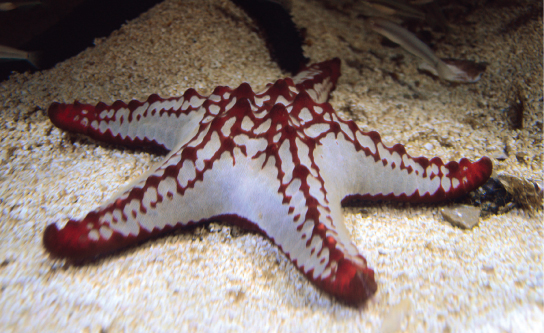
The skeleton of the red-knobbed sea star (Protoreaster linckii) is an example of a hydrostatic skeleton. (credit: “Amada44”/Wikimedia Commons)
Movement in a hydrostatic skeleton is provided by muscles that surround the coelom. The muscles in a hydrostatic skeleton contract to change the shape of the coelom; the pressure of the fluid in the coelom produces movement. For example, earthworms move by waves of muscular contractions of the skeletal muscle of the body wall hydrostatic skeleton, called peristalsis, which alternately shorten and lengthen the body. Lengthening the body extends the anterior end of the organism. Most organisms have a mechanism to fix themselves in the substrate. Shortening the muscles then draws the posterior portion of the body forward. Although a hydrostatic skeleton is well-suited to invertebrate organisms such as earthworms and some aquatic organisms, it is not an efficient skeleton for terrestrial animals.
Exoskeleton
An exoskeleton is an external skeleton that consists of a hard encasement on the surface of an organism. For example, the shells of crabs and insects are exoskeletons (Figure 19.3). This skeleton type provides defence against predators, supports the body, and allows for movement through the contraction of attached muscles. As with vertebrates, muscles must cross a joint inside the exoskeleton. Shortening of the muscle changes the relationship of the two segments of the exoskeleton. Arthropods such as crabs and lobsters have exoskeletons that consist of 30–50 percent chitin, a polysaccharide derivative of glucose that is a strong but flexible material. Chitin is secreted by the epidermal cells. The exoskeleton is further strengthened by the addition of calcium carbonate in organisms such as the lobster. Because the exoskeleton is acellular, arthropods must periodically shed their exoskeletons because the exoskeleton does not grow as the organism grows.
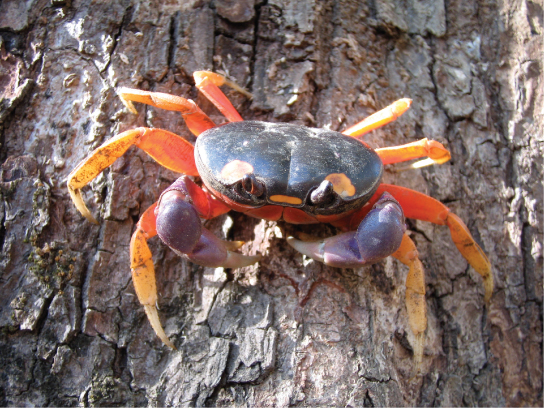
Muscles attached to the exoskeleton of the Halloween crab (Gecarcinus quadratus) allow it to move.
Endoskeleton
An endoskeleton is a skeleton that consists of hard, mineralized structures located within the soft tissue of organisms. An example of a primitive endoskeletal structure is the spicules of sponges. The bones of vertebrates are composed of tissues, whereas sponges have no true tissues (Figure 19.4). Endoskeletons provide support for the body, protect internal organs, and allow for movement through contraction of muscles attached to the skeleton.
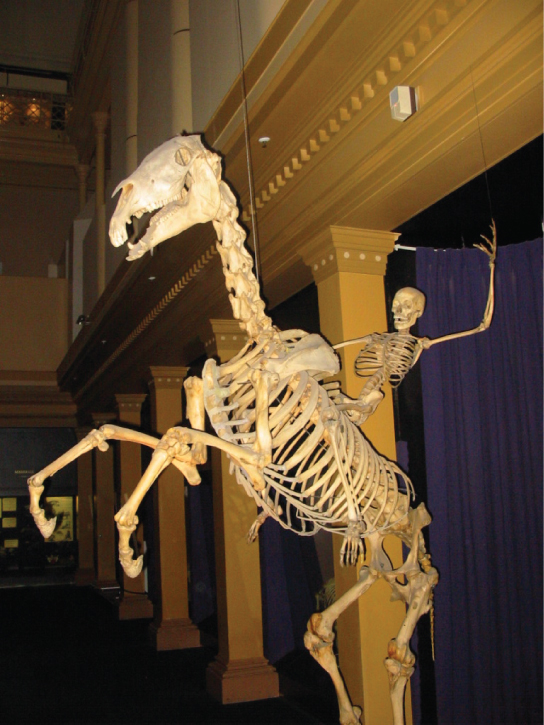
The skeletons of humans and horses are examples of endoskeletons. (credit: Ross Murphy)
The human skeleton is an endoskeleton that consists of 206 bones in the adult. It has five main functions: providing support to the body, storing minerals and lipids, producing blood cells, protecting internal organs, and allowing for movement. The skeletal system in vertebrates is divided into the axial skeleton (which consists of the skull, vertebral column, and rib cage), and the appendicular skeleton (which consists of the shoulders, limb bones, the pectoral girdle, and the pelvic girdle).
Concept in Action

Visit the interactive body site to build a virtual skeleton: select “skeleton” and click through the activity to place each bone.
Human Axial Skeleton
The axial skeleton forms the central axis of the body and includes the bones of the skull, ossicles of the middle ear, hyoid bone of the throat, vertebral column, and the thoracic cage (ribcage) (Figure 19.5). The function of the axial skeleton is to provide support and protection for the brain, the spinal cord, and the organs in the ventral body cavity. It provides a surface for the attachment of muscles that move the head, neck, and trunk, performs respiratory movements, and stabilizes parts of the appendicular skeleton.
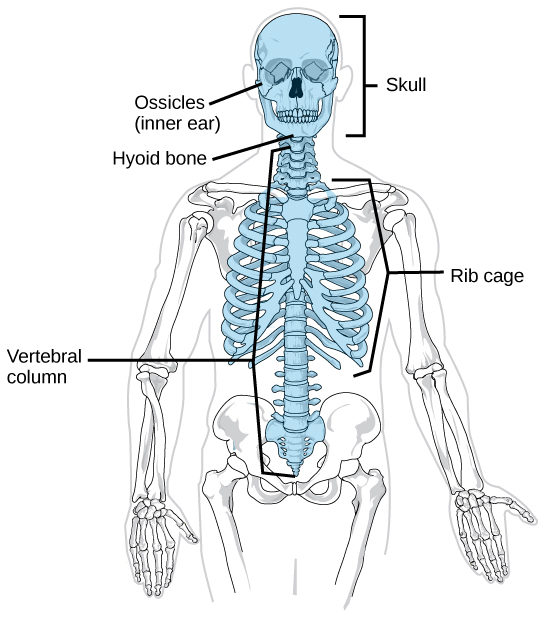
The axial skeleton consists of the bones of the skull, ossicles of the middle ear, hyoid bone, vertebral column, and rib cage. (credit: modification of work by Mariana Ruiz Villareal)
The Skull
The bones of the skull support the structures of the face and protect the brain. The skull consists of 22 bones, which are divided into two categories: cranial bones and facial bones. The cranial bones are eight bones that form the cranial cavity, which encloses the brain and serves as an attachment site for the muscles of the head and neck. The eight cranial bones are the frontal bone, two parietal bones, two temporal bones, occipital bone, sphenoid bone, and the ethmoid bone. Although the bones developed separately in the embryo and fetus, in the adult, they are tightly fused with connective tissue and adjoining bones do not move (Figure 19.6).
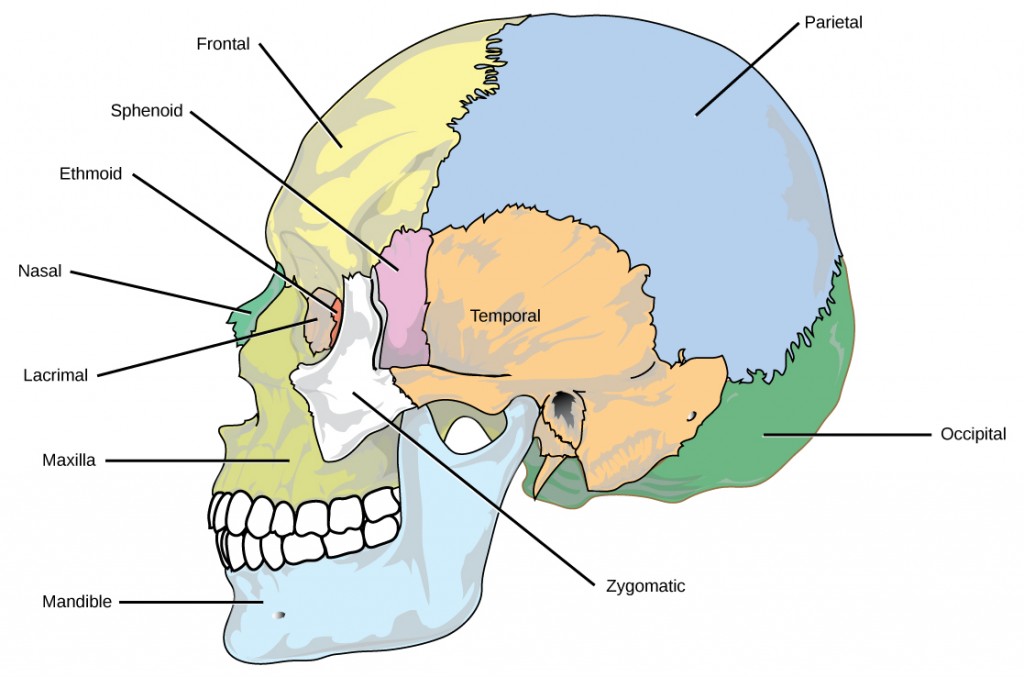
The bones of the skull support the structures of the face and protect the brain. (credit: modification of work by Mariana Ruiz Villareal)
The auditory ossicles of the middle ear transmit sounds from the air as vibrations to the fluid-filled cochlea. The auditory ossicles consist of six bones: two malleus bones, two incus bones, and two stapes on each side. These are the smallest bones in the body and are unique to mammals.
Fourteen facial bones form the face, provide cavities for the sense organs (eyes, mouth, and nose), protect the entrances to the digestive and respiratory tracts, and serve as attachment points for facial muscles. The 14 facial bones are the nasal bones, the maxillary bones, zygomatic bones, palatine, vomer, lacrimal bones, the inferior nasal conchae, and the mandible. All of these bones occur in pairs except for the mandible and the vomer (Figure 19.7).
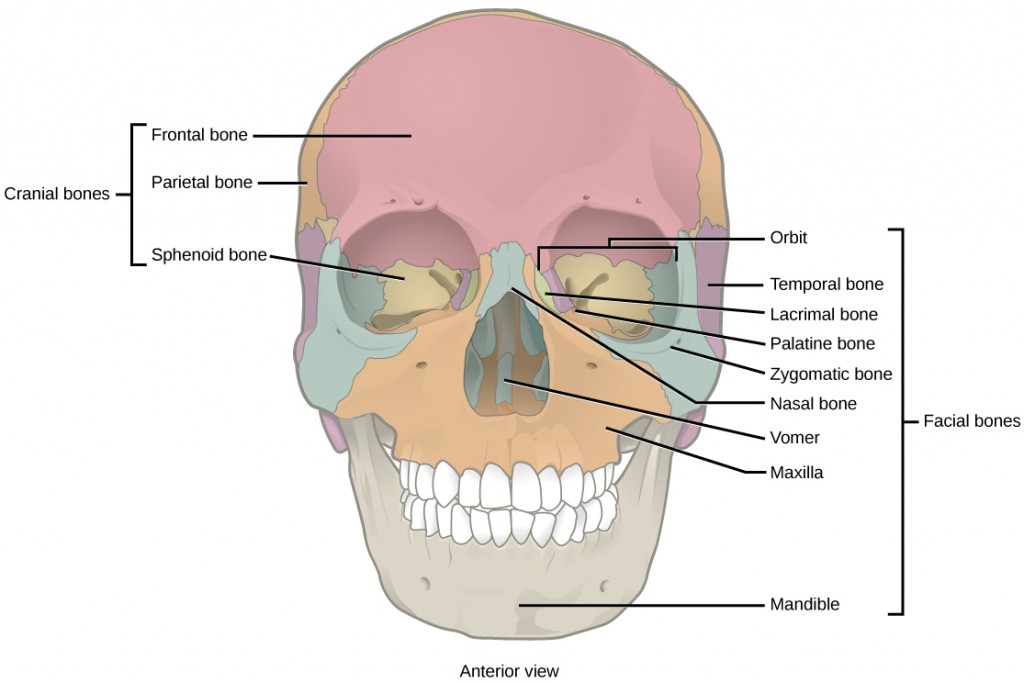
The cranial bones, including the frontal, parietal, and sphenoid bones, cover the top of the head. The facial bones of the skull form the face and provide cavities for the eyes, nose, and mouth.
Although it is not found in the skull, the hyoid bone is considered a component of the axial skeleton. The hyoid bone lies below the mandible in the front of the neck. It acts as a movable base for the tongue and is connected to muscles of the jaw, larynx, and tongue. The mandible articulates with the base of the skull. The mandible controls the opening to the airway and gut. In animals with teeth, the mandible brings the surfaces of the teeth in contact with the maxillary teeth.
The Vertebral Column
The vertebral column, or spinal column, surrounds and protects the spinal cord, supports the head, and acts as an attachment point for the ribs and muscles of the back and neck. The adult vertebral column comprises 26 bones: the 24 vertebrae, the sacrum, and the coccyx bones. In the adult, the sacrum is typically composed of five vertebrae that fuse into one. The coccyx is typically 3–4 vertebrae that fuse into one. Around the age of 70, the sacrum and the coccyx may fuse together. We begin life with approximately 33 vertebrae, but as we grow, several vertebrae fuse together. The adult vertebrae are further divided into the 7 cervical vertebrae, 12 thoracic vertebrae, and 5 lumbar vertebrae (Figure 19.8).
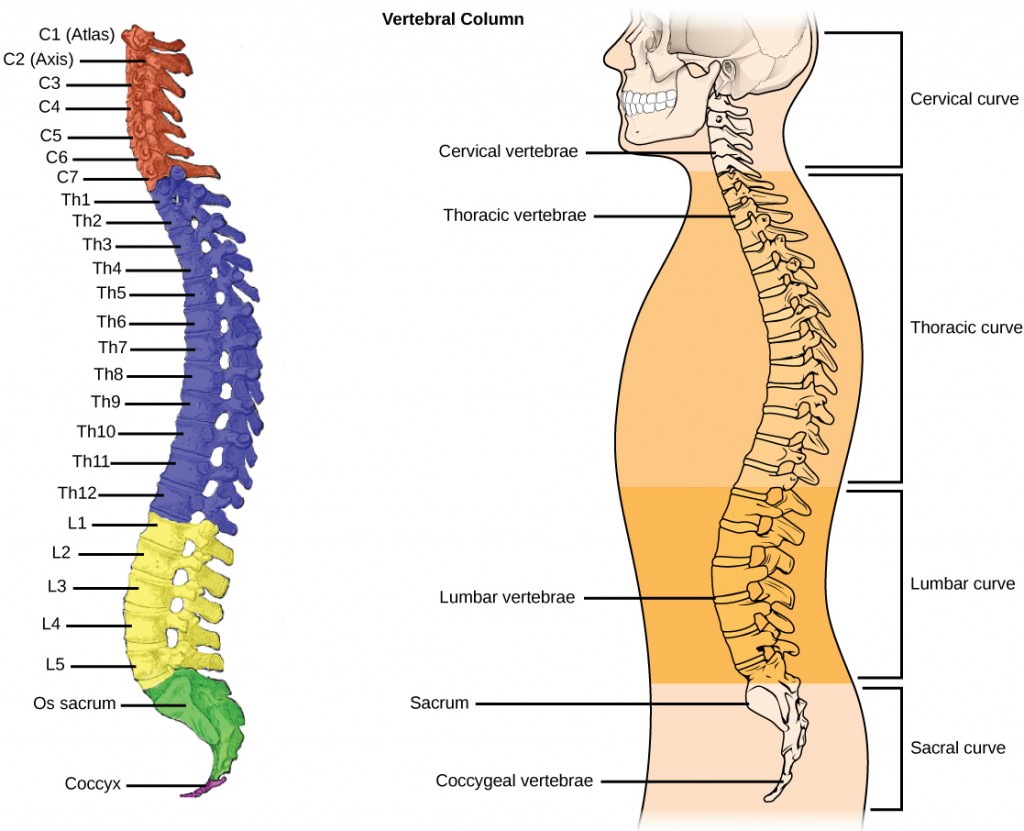
Each vertebral body has a large hole in the center through which the nerves of the spinal cord pass. There is also a notch on each side through which the spinal nerves, which serve the body at that level, can exit from the spinal cord. The vertebral column is approximately 71 cm (28 inches) in adult male humans and is curved, which can be seen from a side view. The names of the spinal curves correspond to the region of the spine in which they occur. The thoracic and sacral curves are concave (curve inwards relative to the front of the body) and the cervical and lumbar curves are convex (curve outwards relative to the front of the body). The arched curvature of the vertebral column increases its strength and flexibility, allowing it to absorb shocks like a spring (Figure 19.8).
The Thoracic Cage
The thoracic cage, also known as the ribcage, is the skeleton of the chest, and consists of the ribs, sternum, thoracic vertebrae, and costal cartilages (Figure 19.9). The thoracic cage encloses and protects the organs of the thoracic cavity, including the heart and lungs. It also provides support for the shoulder girdles and upper limbs, and serves as the attachment point for the diaphragm, muscles of the back, chest, neck, and shoulders. Changes in the volume of the thorax enable breathing.
The sternum, or breastbone, is a long, flat bone located at the anterior of the chest. It is formed from three bones that fuse in the adult. The ribs are 12 pairs of long, curved bones that attach to the thoracic vertebrae and curve toward the front of the body, forming the ribcage. Costal cartilages connect the anterior ends of the ribs to the sternum, with the exception of rib pairs 11 and 12, which are free-floating ribs.
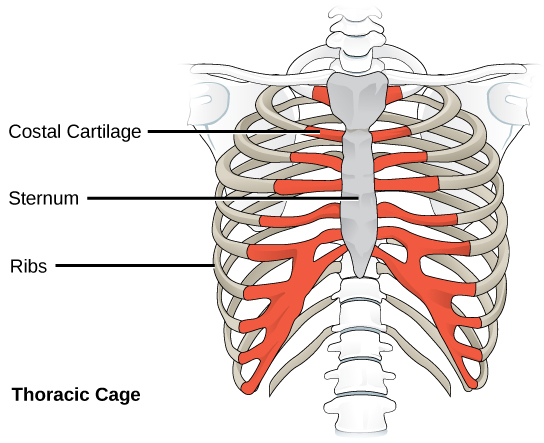
The thoracic cage, or rib cage, protects the heart and the lungs. (credit: modification of work by NCI, NIH)
Human Appendicular Skeleton
The appendicular skeleton is composed of the bones of the upper limbs (which function to grasp and manipulate objects) and the lower limbs (which permit locomotion). It also includes the pectoral girdle, or shoulder girdle, that attaches the upper limbs to the body, and the pelvic girdle that attaches the lower limbs to the body (Figure 19.10).
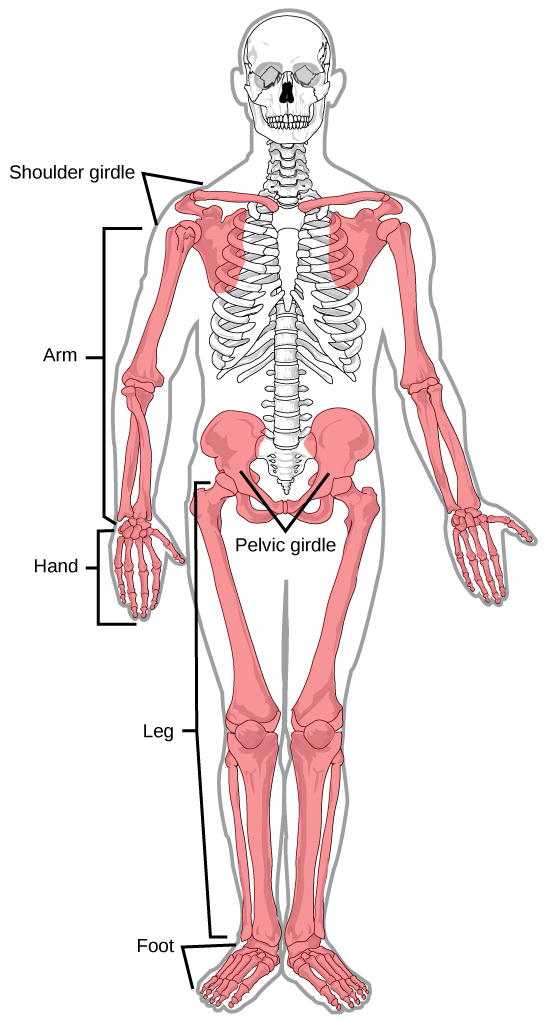
The Pectoral Girdle
The pectoral girdle bones provide the points of attachment of the upper limbs to the axial skeleton. The human pectoral girdle consists of the clavicle (or collarbone) in the anterior, and the scapula (or shoulder blades) in the posterior (Figure 19.11).

(a) The pectoral girdle in primates consists of the clavicles and scapulae. (b) The posterior view reveals the spine of the scapula to which muscle attaches.
The scapulae are flat, triangular bones that are located at the back of the pectoral girdle. They support the muscles crossing the shoulder joint. A ridge, called the spine, runs across the back of the scapula and can easily be felt through the skin (Figure 19.11). The spine of the scapula is a good example of a bony protrusion that facilitates a broad area of attachment for muscles to bone.
The Upper Limb
The upper limb contains 30 bones in three regions: the arm (shoulder to elbow), the forearm (ulna and radius), and the wrist and hand (Figure 19.12).
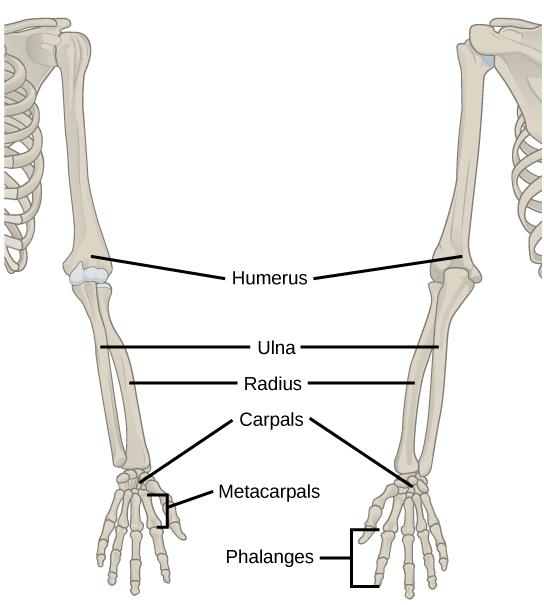
The upper limb consists of the humerus of the upper arm, the radius and ulna of the forearm, eight bones of the carpus, five bones of the metacarpus, and 14 bones of the phalanges.
An articulation is any place at which two bones are joined. The humerus is the largest and longest bone of the upper limb and the only bone of the arm. It articulates with the scapula at the shoulder and with the forearm at the elbow. The forearm extends from the elbow to the wrist and consists of two bones: the ulna and the radius. The radius is located along the lateral (thumb) side of the forearm and articulates with the humerus at the elbow. The ulna is located on the medial aspect (pinky-finger side) of the forearm. It is longer than the radius. The ulna articulates with the humerus at the elbow. The radius and ulna also articulate with the carpal bones and with each other, which in vertebrates enables a variable degree of rotation of the carpus with respect to the long axis of the limb. The hand includes the eight bones of the carpus (wrist), the five bones of the metacarpus (palm), and the 14 bones of the phalanges (digits). Each digit consists of three phalanges, except for the thumb, when present, which has only two.
The Pelvic Girdle
The pelvic girdle attaches to the lower limbs of the axial skeleton. Because it is responsible for bearing the weight of the body and for locomotion, the pelvic girdle is securely attached to the axial skeleton by strong ligaments. It also has deep sockets with robust ligaments to securely attach the femur to the body. The pelvic girdle is further strengthened by two large hip bones. In adults, the hip bones, or coxal bones, are formed by the fusion of three pairs of bones: the ilium, ischium, and pubis. The pelvis joins together in the anterior of the body at a joint called the pubic symphysis and with the bones of the sacrum at the posterior of the body.
The female pelvis is slightly different from the male pelvis. Over generations of evolution, females with a wider pubic angle and larger diameter pelvic canal reproduced more successfully. Therefore, their offspring also had pelvic anatomy that enabled successful childbirth (Figure 19.13).
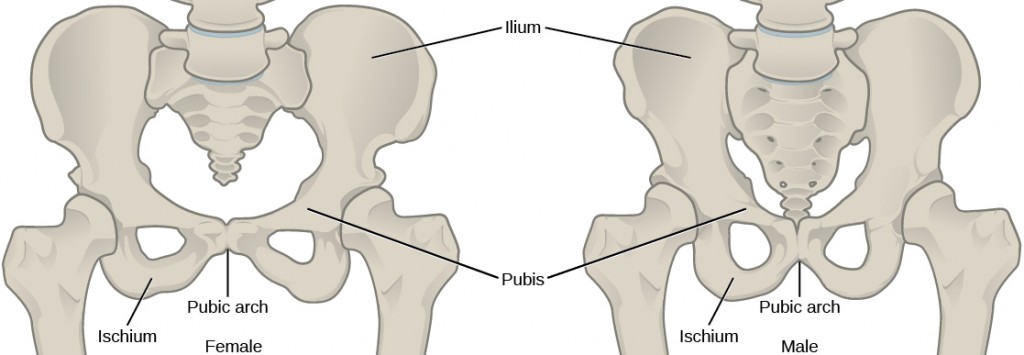
To adapt to reproductive fitness, the (a) female pelvis is lighter, wider, shallower, and has a broader angle between the pubic bones than (b) the male pelvis.
The Lower Limb
The lower limb consists of the thigh, the leg, and the foot. The bones of the lower limb are the femur (thigh bone), patella (kneecap), tibia and fibula (bones of the leg), tarsals (bones of the ankle), and metatarsals and phalanges (bones of the foot) (Figure 19.14). The bones of the lower limbs are thicker and stronger than the bones of the upper limbs because of the need to support the entire weight of the body and the resulting forces from locomotion. In addition to evolutionary fitness, the bones of an individual will respond to forces exerted upon them.
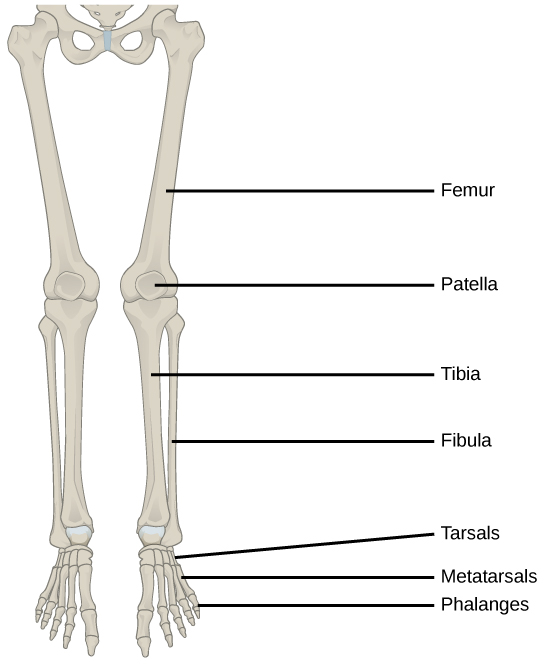
The lower limb consists of the thigh (femur), kneecap (patella), leg (tibia and fibula), ankle (tarsals), and foot (metatarsals and phalanges) bones.
The femur, or thighbone, is the longest, heaviest, and strongest bone in the body. The femur and pelvis form the hip joint at the proximal end. At the distal end, the femur, tibia, and patella form the knee joint. The patella, or kneecap, is a triangular bone that lies anterior to the knee joint. The patella is embedded in the tendon of the femoral extensors (quadriceps). It improves knee extension by reducing friction. The tibia, or shinbone, is a large bone of the leg that is located directly below the knee. The tibia articulates with the femur at its proximal end, with the fibula and the tarsal bones at its distal end. It is the second largest bone in the human body and is responsible for transmitting the weight of the body from the femur to the foot. The fibula, or calf bone, parallels and articulates with the tibia. It does not articulate with the femur and does not bear weight. The fibula acts as a site for muscle attachment and forms the lateral part of the ankle joint.
The tarsals are the seven bones of the ankle. The ankle transmits the weight of the body from the tibia and the fibula to the foot. The metatarsals are the five bones of the foot. The phalanges are the 14 bones of the toes. Each toe consists of three phalanges, except for the big toe that has only two (Figure 19.15). Variations exist in other species; for example, the horse’s metacarpals and metatarsals are oriented vertically and do not make contact with the substrate.

This drawing shows the bones of the human foot and ankle, including the metatarsals and the phalanges.
Evolution of Body Design for Locomotion on Land
The transition of vertebrates onto land required a number of changes in body design, as movement on land presents a number of challenges for animals that are adapted to movement in water. The buoyancy of water provides a certain amount of lift, and a common form of movement by fish is lateral undulations of the entire body. This back and forth movement pushes the body against the water, creating forward movement. In most fish, the muscles of paired fins attach to girdles within the body, allowing for some control of locomotion. As certain fish began moving onto land, they retained their lateral undulation form of locomotion (anguilliform). However, instead of pushing against water, their fins or flippers became points of contact with the ground, around which they rotated their bodies.
The effect of gravity and the lack of buoyancy on land meant that body weight was suspended on the limbs, leading to increased strengthening and ossification of the limbs. The effect of gravity also required changes to the axial skeleton. Lateral undulations of land animal vertebral columns cause torsional strain. A firmer, more ossified vertebral column became common in terrestrial tetrapods because it reduces strain while providing the strength needed to support the body’s weight. In later tetrapods, the vertebrae began allowing for vertical motion rather than lateral flexion. Another change in the axial skeleton was the loss of a direct attachment between the pectoral girdle and the head. This reduced the jarring to the head caused by the impact of the limbs on the ground. The vertebrae of the neck also evolved to allow movement of the head independently of the body.
The appendicular skeleton of land animals is also different from aquatic animals. The shoulders attach to the pectoral girdle through muscles and connective tissue, thus reducing the jarring of the skull. Because of a lateral undulating vertebral column, in early tetrapods, the limbs were splayed out to the side and movement occurred by performing “push-ups.” The vertebrae of these animals had to move side-to-side in a similar manner to fish and reptiles. This type of motion requires large muscles to move the limbs toward the midline; it was almost like walking while doing push-ups, and it is not an efficient use of energy. Later tetrapods have their limbs placed under their bodies, so that each stride requires less force to move forward. This resulted in decreased adductor muscle size and an increased range of motion of the scapulae. This also restricts movement primarily to one plane, creating forward motion rather than moving the limbs upward as well as forward. The femur and humerus were also rotated, so that the ends of the limbs and digits were pointed forward, in the direction of motion, rather than out to the side. By placement underneath the body, limbs can swing forward like a pendulum to produce a stride that is more efficient for moving over land.
Summary
The three types of skeleton designs are hydrostatic skeletons, exoskeletons, and endoskeletons. A hydrostatic skeleton is formed by a fluid-filled compartment held under hydrostatic pressure; movement is created by the muscles producing pressure on the fluid. An exoskeleton is a hard external skeleton that protects the outer surface of an organism and enables movement through muscles attached on the inside. An endoskeleton is an internal skeleton composed of hard, mineralized tissue that also enables movement by attachment to muscles. The human skeleton is an endoskeleton that is composed of the axial and appendicular skeleton. The axial skeleton is composed of the bones of the skull, ossicles of the ear, hyoid bone, vertebral column, and ribcage. The skull consists of eight cranial bones and 14 facial bones. Six bones make up the ossicles of the middle ear, while the hyoid bone is located in the neck under the mandible. The vertebral column contains 26 bones, and it surrounds and protects the spinal cord. The thoracic cage consists of the sternum, ribs, thoracic vertebrae, and costal cartilages. The appendicular skeleton is made up of the limbs of the upper and lower limbs. The pectoral girdle is composed of the clavicles and the scapulae. The upper limb contains 30 bones in the arm, the forearm, and the hand. The pelvic girdle attaches the lower limbs to the axial skeleton. The lower limb includes the bones of the thigh, the leg, and the foot.
Exercises
1. Which of the following statements about bone tissue is false?
A) Compact bone tissue is made of cylindrical osteons that are aligned such that they travel the length of the bone.
B) Haversian canals contain blood vessels only.
C) Haversian canals contain blood vessels and nerve fibers.
D) Spongy tissue is found on the interior of the bone, and compact bone tissue is found on the exterior.
Answer: B
2. The forearm consists of the:
A) radius and ulna
B) radius and humerus
C) ulna and humerus
D) humerus and carpus
Answer: A
3. The pectoral girdle consists of the:
A) clavicle and sternum
B) sternum and scapula
C) clavicle and scapula
D) clavicle and coccyx
Answer: C
4. All of the following are groups of vertebrae except ________, which is a curvature.
A) thoracic
B) cervical
C) lumbar
D) pelvic
Answer: D
A) frontal
B) occipital
C) lacrimal
D) temporal
Answer: C
The female pelvis is tilted forward and is wider, lighter, and shallower than the male pelvis. It is also has a pubic angle that is broader than the male pelvis.
The pelvic girdle is securely attached to the body by strong ligaments, unlike the pectoral girdle, which is sparingly attached to the ribcage. The sockets of the pelvic girdle are deep, allowing the femur to be more stable than the pectoral girdle, which has shallow sockets for the scapula. Most tetrapods have 75 percent of their weight on the front legs because the head and neck are so heavy; the advantage of the shoulder joint is more degrees of freedom in movement.
Glossary
- abduction
- when a bone moves away from the midline of the body
- actin
- globular contractile protein that interacts with myosin for muscle contraction
- appendicular skeleton
- composed of the bones of the upper limbs, which function to grasp and manipulate objects, and the lower limbs, which permit locomotion
- articulation
- any place where two bones are joined
- auditory ossicle
- (also, middle ear) transduces sounds from the air into vibrations in the fluid-filled cochlea
- axial skeleton
- forms the central axis of the body and includes the bones of the skull, the ossicles of the middle ear, the hyoid bone of the throat, the vertebral column, and the thoracic cage (ribcage)
- bone remodeling
- replacement of old bone tissue by new bone tissue
- bone
- (also, osseous tissue) connective tissue that constitutes the endoskeleton
- carpus
- eight bones that comprise the wrist
- clavicle
- S-shaped bone that positions the arms laterally
- compact bone
- forms the hard external layer of all bones
- coxal bone
- hip bone
- cranial bone
- one of eight bones that form the cranial cavity that encloses the brain and serves as an attachment site for the muscles of the head and neck
- diaphysis
- central shaft of bone, contains bone marrow in a marrow cavity
- endoskeleton
- skeleton of living cells that produce a hard, mineralized tissue located within the soft tissue of organisms
- epiphyseal plate
- region between the diaphysis and epiphysis that is responsible for the lengthwise growth of long bones
- epiphysis
- rounded end of bone, covered with articular cartilage and filled with red bone marrow, which produces blood cells
- exoskeleton
- a secreted cellular product external skeleton that consists of a hard encasement on the surface of an organism
- extension
- movement in which the angle between the bones of a joint increases; opposite of flexion
- facial bone
- one of the 14 bones that form the face; provides cavities for the sense organs (eyes, mouth, and nose) and attachment points for facial muscles
- femur
- (also, thighbone) longest, heaviest, and strongest bone in the body
- fibula
- (also, calf bone) parallels and articulates with the tibia
- flat bone
- thin and relatively broad bone found where extensive protection of organs is required or where broad surfaces of muscle attachment are required
- flexion
- movement in which the angle between the bones decreases; opposite of extension
- forearm
- extends from the elbow to the wrist and consists of two bones: the ulna and the radius
- Haversian canal
- contains the bone’s blood vessels and nerve fibers
- humerus
- only bone of the arm
- hydrostatic skeleton
- skeleton that consists of aqueous fluid held under pressure in a closed body compartment
- hyoid bone
- lies below the mandible in the front of the neck
- joint
- point at which two or more bones meet
- lamella
- layer of compact tissue that surrounds a central canal called the Haversian canal
- long bone
- bone that is longer than wide, and has a shaft and two ends
- lower limb
- consists of the thigh, the leg, and the foot
- metacarpus
- five bones that comprise the palm
- metatarsal
- one of the five bones of the foot
- myofibril
- long cylindrical structures that lie parallel to the muscle fiber
- myosin
- contractile protein that interacts with actin for muscle contraction
- osseous tissue
- connective tissue that constitutes the endoskeleton
- ossification
- (also, osteogenesis) process of bone formation by osteoblasts
- osteoblast
- bone cell responsible for bone formation
- osteoclast
- large bone cells with up to 50 nuclei, responsible for bone remodeling
- osteon
- cylindrical structure aligned parallel to the long axis of the bone
- patella
- (also, kneecap) triangular bone that lies anterior to the knee joint
- pectoral girdle
- bones that transmit the force generated by the upper limbs to the axial skeleton
- pelvic girdle
- bones that transmit the force generated by the lower limbs to the axial skeleton
- phalange
- one of the bones of the fingers or toes
- protraction
- anterior movement of a bone in the horizontal plane
- radius
- bone located along the lateral (thumb) side of the forearm; articulates with the humerus at the elbow
- rib
- one of 12 pairs of long, curved bones that attach to the thoracic vertebrae and curve toward the front of the body to form the ribcage
- scapula
- flat, triangular bone located at the posterior pectoral girdle
- skull
- bone that supports the structures of the face and protects the brain
- sternum
- (also, breastbone) long, flat bone located at the front of the chest
- suture
- short fiber of connective tissue that holds the skull bones tightly in place; found only in the skull
- symphysis
- hyaline cartilage covers the end of the bone, but the connection between bones occurs through fibrocartilage; symphyses are found at the joints between vertebrae
- tarsal
- one of the seven bones of the ankle
- thoracic cage
- (also, ribcage) skeleton of the chest, which consists of the ribs, thoracic vertebrae, sternum, and costal cartilages
- tibia
- (also, shinbone) large bone of the leg that is located directly below the knee
- tropomyosin
- acts to block myosin binding sites on actin molecules, preventing cross-bridge formation and preventing contraction until a muscle receives a neuron signal
- ulna
- bone located on the medial aspect (pinky-finger side) of the forearm
- vertebral column
- (also, spine) surrounds and protects the spinal cord, supports the head, and acts as an attachment point for ribs and muscles of the back and neck

